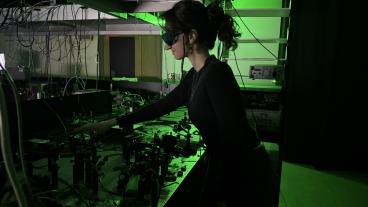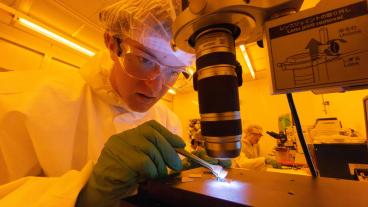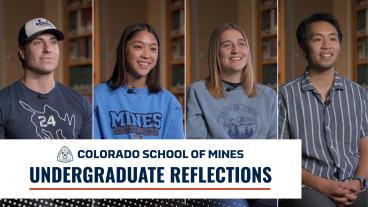Students at Colorado School of Mines, Metropolitan State University of Denver and University of Colorado Denver are helping tackle a major problem facing urban waterways in Denver and beyond.
Trash.
“Every week, crews that work up and down mostly the South Platte River pull out enough trash to fill a 30-cubic-yard dumpster,” said Devon Buckels, director of The Water Connection, the water resources and policy initiative of The Greenway Foundation in Denver. “That’s the equivalent of seven pickup truck loads.”
In dollars, that amounts to $1.25 million spent every year in Denver alone manually picking up trash from rivers and streams, she said.
But what if a device could be placed in stream to do that same work – more effectively and at lower cost?
That was the question posed to the six student teams from three universities competing in the finals of the Clean River Design Challenge on April 10 – including two Capstone Design teams from Mines.
Each team received $1,000 to build a working scaled prototype of an in-stream trash removal device for testing in a specially built flume at the U.S. Bureau of Reclamation Hydraulics Lab in the Denver Federal Center. The winning team would get the opportunity to see their design become a full-scale pilot program in a section of Cherry Creek in Denver’s Lower Downtown neighborhood.
The results were six very different designs, with Go with the Float, a screened conveyor belt system from one of the Mines teams, claiming second-place honors. The overall winner was a team from MSU Denver.
“The system we have now is manual pickup and it’s not working,” Buckels said. “On April 21, we’re doing a river sweep – over 500 volunteers are going to be working sections of South Platte River, picking up trash manually – but it’s only a Band-Aid solution. A week later, you can walk that stretch of river and the trash will be back.”
In the finals, all of the student designs were subject to low- and high-flow tests in the flume, with packing peanuts, plastic wrappers, deflated balloons and tiny plastic bottles simulating the types of trash that gum up urban waterways. In addition to the amount of trash collected, designs were also judged on their impact to the river, ease of installation and maintenance and aesthetics.
Go with the Float’s electric-powered moving screened ramp pulled the tiny trash up out of the water as it floated by, dropping it into a chute leading to a single collection point at the rear of the device. At full scale, the collection bin could hold roughly 50 pounds of trash and would have sensors to notify maintenance crews if it reached capacity prior to the regularly scheduled pickup.
“The big thing we were going for was making it easy for the maintenance workers who would be dealing with this every day. We don’t want anyone in the water,” said Bud Ortega, a member of Team Go with the Float and a senior majoring in mechanical engineering. “At the end of the day, we wanted to take a daylong job for multiple people and make it something that can be done in 20 minutes.”
Also on the team were Morgan Farmer (environmental engineering), Evan Lukens (mechanical engineering), Mason Manross (environmental engineering), Adiya Saginova (mechanical engineering), Dan Scott (civil engineering) and Jayce Stricherz (environmental engineering).
The other Mines team, Dream Stream, earned first place in the challenge’s initial design round last semester but didn’t fare quite as well in the finals. In the test flume, much of the trash swirled past the floating planter boxes that were intended to funnel trash and debris toward the system's paddlewheel collection point. Still, the team felt the test went well.
“The proof of concept was there – the execution just wasn’t there yet,” said Brendan Aleksivich, a senior majoring in mechanical engineering.
“Trial and error is key,” said teammate and fellow mechanical engineering senior Henry Myers. “A lot of it is just figuring out what works and what doesn’t work.”
Also on Team Dream Stream were Brielle Asato (environmental engineering), Daniel Martinez (environmental engineering), Ian Miller (environmental engineering) and Zhongwei Teng (mechanical engineering).
Now in its second year, the goal of the Clean River Design Challenge is to raise awareness about the urban waterway trash problem and try to develop innovative solutions, Buckels said.
Sponsoring the event this year were The Gateway Fund of The Denver Foundation, Denver Water, Denver Department of Public Health and Environment, ECI Construction, DHM Design, Wright Water Engineers and STEAM on the Platte.
“Students are innovative and smart and creative and they come up with things that the rest of us may not,” Buckels said. “There’s a tremendous value in allowing them to apply their smarts and skills to solve this problem. They’re motivated to try.”
CONTACT
Emilie Rusch, Public Information Specialist, Communications and Marketing | 303-273-3361 | erusch@mines.edu
Mark Ramirez, Managing Editor, Communications and Marketing | 303-273-3088 | ramirez@mines.edu



